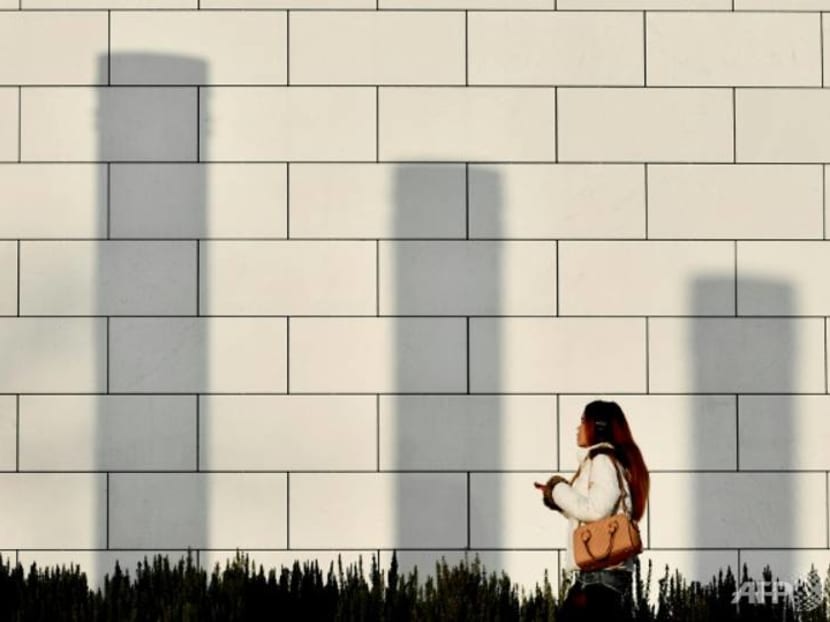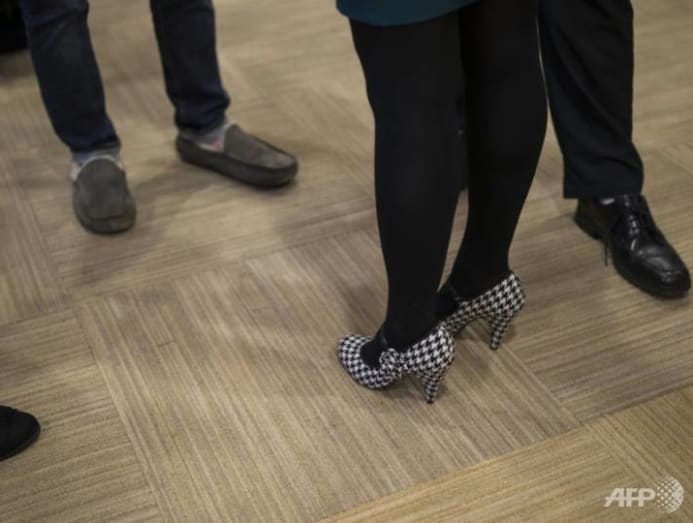Commentary: The unequal, unnoticed life of a female worker
Advertisement
Commentary
Commentary: The diff, unnoticed life of a female worker
Gender inequality manifests itself in tranquility ways that aren't often picked up, in unpaid care work and diff pay for equal piece of work, says Aware's Shailey Hingorani.

(Photo: AFP/FABRICE COFFRINI)
05 November 2022 06:20AM (Updated: 03 Jul 2022 03:09PM)
SINGAPORE: In Singapore, women earn a staggering S$640,000 less than their male counterparts over a 40-year career.
The differential, which includes CPF contributions, was calculated equally function of AWARE's ongoing research on how the labour market place treats women unfairly and what the government, employers, and trade unions can do to address gender inequality at the workplace.
The recent spate of conversations on Oxfam's Delivery to Reducing Inequality Index omitted one of its almost significant findings - how gender inequality contributes to economic inequality.
How does gender inequality manifest itself in a land where men and women have equal opportunities to pedagogy and jobs?
It takes iii insidious forms: Unequal pay for equal piece of work, unpaid care work, and the fact that the labour marketplace sorts men into higher-paying jobs and women into low-wage piece of work.
UNEQUAL PAY FOR EQUAL WORK
Using the Manpower Ministry's Labour Strength Survey information on median monthly incomes of male person and female person employees who worked full-time to calculate the gender wage gap over a 40-twelvemonth menstruation to cover an private's most productive work years, we found the gender wage gap has narrowed over the past decade merely remains persistent across age groups, occupational categories, and hierarchical positions.

In 2016, women earned less than men in all occupational categories except clerical support. The gap at the pinnacle of the career ladder, where women are underrepresented, is even worse. A beggarly 10 per cent of all corporate directors of SGX-listed firms are women, and they are paid a whopping 43 per cent less than their male person counterparts.
What makes the wage gap possible?
Gendered social norms that inherently devalue women'south labour, and lack of policies that require employers to offer equal pay for equal work. In the workplace, women proceed to face additional barriers - including gender bias, both conscious and unconscious, which issue in unequal opportunities, choices and outcomes.
We regularly see women who are discriminated against considering of their motherhood or pregnancy status, women who are harassed at work, and women who are passed over for a promotion because of stereotypes that dictate what women "can" achieve.
READ: Overlooked and underpaid, women must speak upwards and put themselves out there, a commentary
Information technology is easy to dismiss some of these claims as uncommon, later on all Manpower Ministry building statistics show only 57 pregnancy-related unfair dismissals in 2016.
However, these numbers would exist much higher if the data took into account the full range of maternity related workplace cases of well-performing significant employees whose contracts are inverse from full-time to office-time, salaries reduced, positions demoted, and those who are forced to resign, presently after their employers find out nearly their pregnancy.
Make no fault, the gender wage gap not only affects women'southward ability to make an income in their productive years, it also undermines their power to salvage for their retirement needs.

Singapore has definitely made some progress in narrowing the gender gap in CPF savings, just at that place is nonetheless a gap of around xi per cent between the average CPF balances of women and men. With women living longer than men they demand more, not less, retirement savings.
UNPAID CARE Piece of work IS Notwithstanding WOMEN'South Work
Despite moves to encourage shared responsibility within households and between households, and the public provision of certain care facilities, domestic work, including providing care to children and elderly, and household chores, is still considered a female person responsibleness.
This work, which remains largely invisible and unpaid, has a directly effect on labour market outcomes, particularly with respect to female person labour force participation, the gender wage gap, and fifty-fifty the duration, quality and type of paid work that women can undertake.
READ: Are women withal expected to do nearly of the housework? A commentary
In 2016, 78 per cent of prime working-age women outside the labour force were non working because of family responsibilities, including caregiving. The comparable percentage of men outside the labour strength was a puny ix.6 per cent. This gap in labour force participation between men and women farther widens their earnings' gap and therefore their retirement savings.
"Why can't women just try harder?" is a question we are often asked at talks and events on gender inequality, suggesting difficult piece of work and the right attitude as an easy remedy to women'due south workplace woes.
When women try to stay in jobs that do not provide paid childcare leave past taking unpaid exit to care for their sick kid, they are dismissed for being "unreliable". When they try to detect new work, employers practise not hire them because they practise non want workers whose attention is divided between caregiving responsibilities and work.

In contrast, having kids does non affect men's salaries, a recent study of careers of men and women in Kingdom of denmark shows, and hardly affects their careers in terms of the type of jobs they gravitate towards.
READ: 'Super mums' have one unproblematic asking. Don't hinder them from returning to work, a commentary
WOMEN ARE FORCED TO CHOOSE Depression-WAGE Piece of work
A typical refrain of skeptics of the gender wage gap is that women but "cull" lower paying jobs, which conveniently ignores the structural conditions that pb to gender inequality in the first place.
Yes, it is true that women are over-represented in low-paying jobs in the social care industry and in cleaning, jobs considered to exist natural extensions of their domestic roles in the private sphere.
It is not that women are deliberately choosing low-paying jobs but that the jobs they exercise are valued less than the jobs that men exercise. Empirical evidence shows that when a large number of women became designers in the US, wages occupation-wide savage by 34 per cent. When they became biologists, wages fell by 18 per cent.
Is this because women are seen as being of lesser worth? If so, the embedded misogyny needs to be tackled by not condoning any expression of information technology.
READ: Should a homo be expected to earn more than than his married woman? A commentary

Some other explanation for women's over-representation in depression-paying jobs has indeed to do with choice, simply more importantly the social context in which they make the choice.
Women are not simply choosing low-paying jobs, they are choosing the types of jobs that provide temporal flexibility required to attend to their caregiving responsibilities. These jobs tend to be shift-based, role-time, low-paying, and precarious.
A possible alternative could exist to create more flexible jobs to allow employees of all sexes to residue their career and caring responsibilities and so that those looking for flexibility are not automatically pushed into the low-paying informal sector.
READ: Married couples want meliorate work-life balance, a commentary
So WHAT Tin can WE DO?
Fortunately, we can still take concrete steps to address the gender wage gap. Offset, public policy can encourage private sector companies with more than 250 employees to publish their median male person and female person wages.
In Uk, employees have used published wage data to talk to their managers almost the physical steps - such as training on unconscious bias for all their employees, evaluation of hiring and retention policies - that they plan to accept to brand workplaces more inclusive.
Second, the Singapore Government should disallow unequal remuneration for equal work in all sectors of the economy. Information technology should go beyond promoting Tripartite Guidelines on Fair Employment Practices to providing employers with incentives to organise regular unconscious gender-bias training for managers and HR professionals, and to conspicuously communicate their grievance treatment procedures to their employees.
READ: Gender equality is non just a 'women's issue', a commentary

Finally, we must recognise, reduce and redistribute caregiving responsibilities then that they go a shared social responsibility. The provision of free childcare, increased investments in eldercare infrastructure, more than flexible working arrangements, and paid family intendance leave are some measures known to reduce adverse labour outcomes for women.
As nosotros go on our fight against economic inequality, let'due south bear in mind that addressing gender inequality is of critical importance for realising a Singapore that cares for all.
Shailey Hingorani is head of advocacy and research for the Clan of Women for Action and Enquiry (Enlightened)
Contempo Searches
Trending Topics
Source: https://cnalifestyle.channelnewsasia.com/commentary/gender-equality-equal-pay-singapore-work-cpf-life-savings-219361

0 Response to "Commentary: The unequal, unnoticed life of a female worker"
Post a Comment